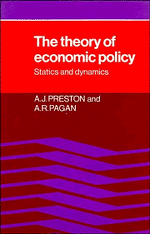Book contents
- Frontmatter
- Contents
- Preface
- Part I The static theory of policy
- Part II Dynamic fixed objectives: on hitting points and paths
- 4 The dynamic policy problem: models and objectives
- 5 Controllability properties of dynamic policy models
- 6 Observability properties of dynamic policy models
- 7 The dynamic theory of stationarity objectives
- 8 The dynamic theory of path objectives
- 9 Policy design for path objectives
- 10 Rational expectations and the theory of policy
- Part III Dynamic flexible objectives: on tracking points and paths
- References
- Index
8 - The dynamic theory of path objectives
Published online by Cambridge University Press: 05 November 2011
- Frontmatter
- Contents
- Preface
- Part I The static theory of policy
- Part II Dynamic fixed objectives: on hitting points and paths
- 4 The dynamic policy problem: models and objectives
- 5 Controllability properties of dynamic policy models
- 6 Observability properties of dynamic policy models
- 7 The dynamic theory of stationarity objectives
- 8 The dynamic theory of path objectives
- 9 Policy design for path objectives
- 10 Rational expectations and the theory of policy
- Part III Dynamic flexible objectives: on tracking points and paths
- References
- Index
Summary
Introduction
Conceptually distinct from the stationarity objective is the target path objective, most simply described when defined in Section 4.3 as a consecutive sequence of arbitrary point objectives. In vivid contrast to the stationarity objective, the path objective ruthlessly discards any overt connections with the static policy heritage anduncompromisingly poses its own specific dynamic problem. Accordingly, in its technical analysis the Gordian decomposition of mappings characteristic of the stationarity analysis disappears and in further elaboration of another typical feature of dynamic analysis, as introduced in Chapter 5, emphasis on an appropriate nested, time-indexed sequence of linear mappings re-emerges.
As for any dynamic policy problem, so for the path problem a quartet of issues – existence, uniqueness, stability and design – awaits analysis. Existence issues will form the basis of this chapter, and Chapter 9 will then refer to the remaining trio of issues, but with primary emphasis on design. It should be noted that this chapter is intended as a specific sequel to the paper on path controllability by Preston and Sieper (1977). Sections 8.2–8.4 and Section 8.7 largely convey ideas and material from that earlier paper; Sections 8.5, 8.6 and 8.8 extend that analysis, as does Chapter 9.
Section 8.2 formulates the path existence problem and derives some immediate existence propositions by application of the linear mapping theory of Chapter 2. Because every path problem comprises a sequence of point problems, properties of the target point problem are necessarily crucial to the path problem: Section 8.3 therefore analyses this trivial or polar path problem.
Information
- Type
- Chapter
- Information
- The Theory of Economic PolicyStatics and Dynamics, pp. 229 - 258Publisher: Cambridge University PressPrint publication year: 1982
